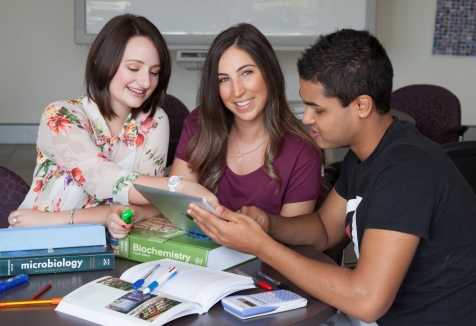Blended learning at UWS

As UWS works towards meeting the challenge of making learning and teaching more accessible and flexible, there has been a lot of talk around blended learning – but what exactly is it?
"I define blended learning as good pedagogical practices using a variety of delivery mechanisms that allow students flexibility and confirm the validity of their experiences," says James Arvanitakis, Professor within the School of Humanities and Communication Arts and 2012 University Teacher of the Year.
Blended learning can take many forms, including activities in lecture theatres and interactivity within the online environment. Technology is a key element of blended learning and iPads are creating opportunities for more flexibility in student learning, both within and outside the classroom.
UWS recognises the importance of offering flexible times and modes of learning, integrating the best aspects of face-to-face and online interactions for each discipline.
In the School of Medicine, tutors and lecturers are using iPad technology in various ways within their curriculum.
Bronwen Dalziel from the School of Medicine has been integrating iPads into lectures and coursework. She says, "My favourite iPad activity so far has been designing a practical with Joanne Lind, a senior lecturer from the School of Medicine, where medical students were required to record their diet, exercise and sleep for three days using freely available applications such as MyFitnessPal and RunKeeper." Results were uploaded into a shared spreadsheet for immediate analysis via GoogleDocs. GoSoapBox (opens in a new window), an application that can be used to generate quizzes, polls and discussion, was then used to generate discourse around using technology in health interventions.
"They responded positively to the different technologies that were needed to take part in the practical session. GoSoapBox kept them focused on their topics and they were able to talk about the issues around health interventions in a much more engaged manner than in previous practical sessions," says Bronwen.
Bronwen has noticed an increase in the number of students who are using PDF annotation software to make notes with their iPads during lectures. "They really liked that I added pop-out annotations to their downloaded lecture notes and kept the presentation slides clean," she says.
"The iPad has been used as part of the Medicine-in-Context component of the Bachelor of Medicine," says Glenn Mason, E-Learning Manager within the School of Medicine. "Students use it to record and reflect on aspects of their community experiences while on their community attachments. They then use the iPad to aggregate their experiences, reflections and ideas into an iPad presentation, which they present to their peers during tutorial sessions. These are used as triggers for discussing a wide range of topics."
Glenn says the students have enjoyed using the iPads as part of their tutorial sessions. "They liked getting a visual representation of the various community organisations and often used the presentations to talk about wider issues," he says. "They felt inspired by the presentations and felt it helped them recall discussions about particular organisations."
To find out more about blended learning at UWS, head to a Blended Learning Forum. The next forum will be held at Bankstown campus on Tuesday 16 July from 10am to 12.30pm.
Webinars and customised in-School professional development sessions are available for interested staff on the Events, Workshops and Forums webpage (opens in a new window). Resources and more information about Blended Learning are also available on the QiLT Hub (opens in a new window).
If you need more information about how to use your iPad, visit the Quality in Learning and Teaching Hub's guide, Using the iPad (opens in a new window).
Mobile options:

